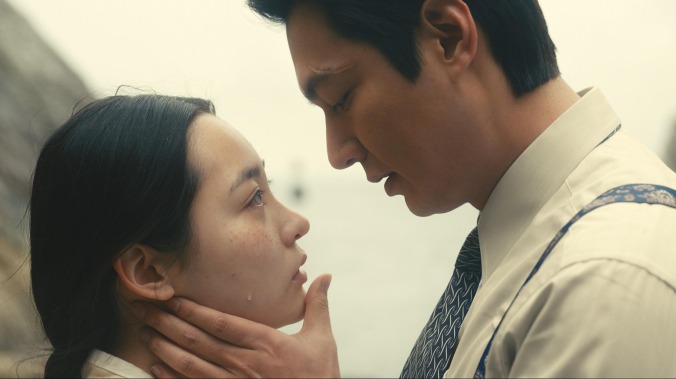Apple TV Plus’ Pachinko is an immersive, poignant, must-see journey
Anchored by exceptional performances and cinematography, Pachinko is a momentous multigenerational drama

Let’s get this out of the way: Pachinko is an extraordinary drama. Based on Min Jin Lee’s 2017 novel of the same name, it masterfully weaves the intricate tapestry of a Korean family with an expansive scope, spanning different cities, languages, and generations. The show is at once an educational, sweeping saga (about culture, history, politics, romance, and lineage), and a pointed story about its protagonist, Sunja, and her loved ones at various times in their lives. As such, it’s brimming with ideas, and conveys them really well.
Sunja first shows up as a resourceful 8-year-old (Jeon Yu-Na) residing on a small fishing island near Busan in 1920s Korea, then occupied by Japan and rife with militant rule and racism. As a young adult (played by Minha Kim), she helps her mother run a boarding house. After getting caught up in a reckless love affair, Sunja moves to Osaka amidst political turmoil and indigence. The story then goes back-and-forth between her early attempts to assimilate, and an older Sunja (Minari’s Youn Yuh-Jung) in 1989, now living comfortably in Japan with her son Baek Mozasu (Soji Arai).
So Pachinko takes place primarily in two Asian countries during highly combative times, with the dialogue in Korean and Japanese (helpfully subtitled in yellow and blue, respectively). Yet there’s an unwavering universal resonance with the show’s—and its source material’s—exploration of freedom and identity. Pachinko is timeless in how it grapples with the complexities of immigration during very specific times, and the writing accurately captures the longing for—and meaning of—home.
In the 1989 portion, Sunja’s workaholic grandson Solomon Baek (Jin Ha) arrives from the U.S. to secure a critical deal for his bank and land a VP promotion. The show switches to his point-of-view at times; it’s one that Stateside viewers are probably most familiar with. Having established a successful career in New York City, Solomon has a conflicted relationship with Japan (where he was raised) and Korea (his ancestral country). Thankfully, the transition between all these perspectives is seamless and never tedious.
The timeline-hopping differs from the book’s effective chronological structure, but the choice leads to some stunning visual rewards. In episode four, for instance, Sunja bids her mother and friends a tearful goodbye while leaving Busan on (literally) choppy waters, not knowing if she’ll ever see them again. The scene cuts to a wistful Sunja decades later at the airport, finally visiting her homeland with her son Mozasu.
Mozasu owns a parlor for pachinko—a popular game commonly found in Japanese arcades—whose players rely on luck to win. The game is an intriguing motif, and serendipity factors into the show in wonderful ways. Chance encounters and subsequent prudent decisions have altered Sunja’s course, whether it’s how she meets and marries Protestant minister Baek Isak (Steve Sanghyun Noh), or her judicious use of an expensive watch gifted to her by her former lover.
The parlor is the setting for Pachinko’s electrifying opening credits, which even outdo Peacemaker in the fun department, so skipping the intro here is not an option. During it, snapshots of the countries’ tragedies appear, only to be followed by the cast freely dancing to The Grass Roots’ “Let’s Live For Today.” It’s a moving depiction of endurance, and no one in the show encapsulates this feeling more than Kim’s take on Sunja.
She’s Pachinko’s linchpin. All three actors are up to the task to evolve the character, from a promising child actor to a soulful Oscar winner. But Kim’s version is the standout. A relative newcomer, she has to carry Sunja’s toughest years. She instantly embodies the character’s naiveté and gradually molds her into an unbreakable force of nature. Every expression—a painful sob, a longing look, a moment of pride—is transfixing and all too real.
The remaining ensemble is compelling, too, especially Jeong In-Ji, who gives an emotional, natural turn as Sunja’s mother, Yangjin. Ha also brings nuance to Solomon despite his journey slowing down Pachinko’s pace in the second half. The whole bank deal situation does drag out, ever-so-slightly marring the show’s overall triumph. But his story leads to Pachinko’s most heart-rending scenes: a sincere conversation between Youn’s Sunja and his potential client, another Korean immigrant, about the struggle to move on from their hardships. (Fair warning to keep tissues handy; the tears will flow).
Lee Min-Ho, known for being an endearing romantic lead, is exceptional as the antihero Koh Hansu, a wealthy fish broker with ties to the Japanese crime world. His entanglement with teenage Sunja upends her life. Lee’s scattered appearances build up to episode seven, which is entirely about his own tragic upbringing. (The hour’s contents are a departure from the book and shed a light on the devastating 1923 Kanto earthquake.)
The production design and cinematography are just as key to Pachinko, as the characters travel from boardrooms to narrow cobbled lanes, scenic islands to big cities, and devastation to solace. Kogonoda and Justin Chon’s direction elevates the script. Through their eyes, even something as simple as white rice holds court onscreen, whether it’s Yangjin preparing it as a final luxurious meal before her daughter leaves or Youn’s Sunja recognizing the nutty taste of her homeland’s staple, now easily available food.
Only three months into 2022, it’s hard not to proclaim Pachinko as one of the best new shows of the year, or years even. Luckily, season one hasn’t covered the entirety of the novel, leaving room for plenty more to uncover in any future installments. Here’s hoping. Because it would be something of a travesty if a multigenerational story this exceptional didn’t get a second shot.